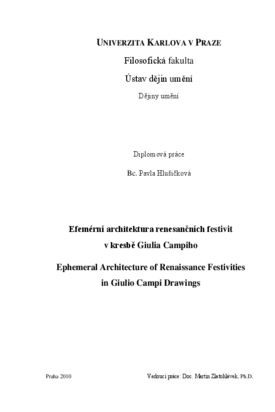Efemérní architektura renesančních festivit v kresbě Giulia Campiho
Ephemeral architecture of Renaissance festivies in Giulio Campi drawings
diploma thesis (DEFENDED)

View/
Permanent link
http://hdl.handle.net/20.500.11956/33476Identifiers
Study Information System: 100277
CU Caralogue: 990012916260106986
Collections
- Kvalifikační práce [24986]
Author
Advisor
Referee
Konečný, Lubomír
Faculty / Institute
Faculty of Arts
Discipline
History of Art
Department
Institute of Art History
Date of defense
3. 2. 2011
Publisher
Univerzita Karlova, Filozofická fakultaLanguage
Czech
Grade
Excellent
Keywords (Czech)
Giulio Campi, Cremona, trionfo, efemérní architekturaKeywords (English)
Giulio Campi, Cremona, trionfo, ephemeral architectureDiplomová práce informuje o životě a díle cremonského malíře, architekta a dekoratéra Giulia Campiho (cca 1502-1572), který se v roce 1541 stal autorem dekorací pro triumfální vjezd císaře Karla V. do Cremony. Spolu se svým spolupracovníkem Camillem Boccaccinem navrhl celou řadu slavobran, jejichž podoba se do dnešních dnů dochovala na přípravných kresbách. Několik přípravných kreseb, které jsou součástí v nedávné době objeveného alba Clary - Aldringenů z Teplic, uchovává Národní galerie v Praze. Diplomová práce se dotýká problematiky Campiho návrhů slavobran - řeší výtvarné vlivy, které mohly mít na Campiho kresebný výraz vliv, uvádí další dochované kresby z evropských sbírkových institucí a shrnuje podobu trionfa Karla V. v roce 1541 a Filipa II. v roce 1549 do Cremony.
This dissertation informs about the life and work cremonese painter, architect and decorator Giulio Campi (c. 1502-1572), who became in 1541 the author of the decorations for the triumphal entry of Emperor Charles V in Cremona. Together with his colleague Camille Boccaccino suggested a number of triumphal arches, whose appearance has been preserved to this day on preparatory drawings. A number of preparatory drawings, which are part of the recently discovered album of the Clara - Aldringen in Teplice, keep the National Gallery in Prague. This thesis concerns the problems of Campi's proposals of the arches - addresses visual effects that might have had an influence on the Campi's drawing expression, features other Campi's surviving drawings from the collection of the European institutions and summarizes a form of the Charles V Trionfo in 1541 and Philip II. Trionfo in 1549 in Cremona.
